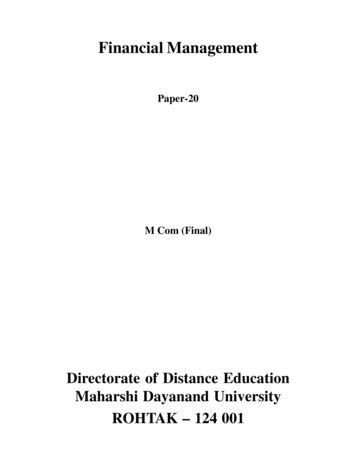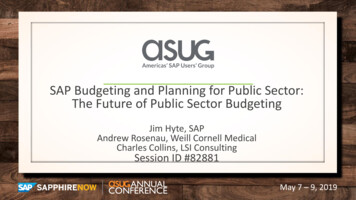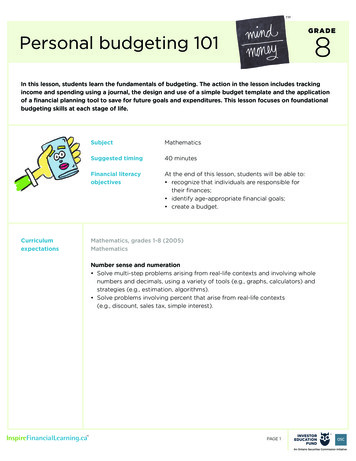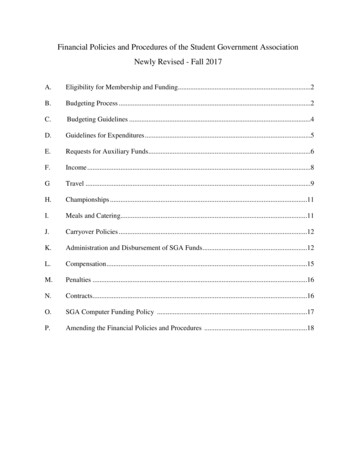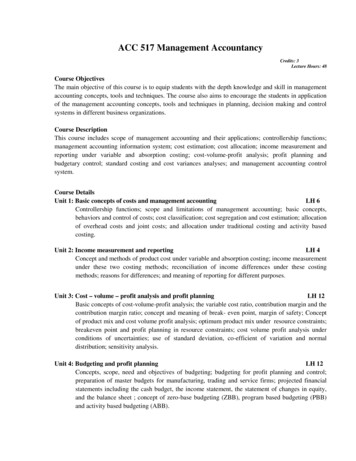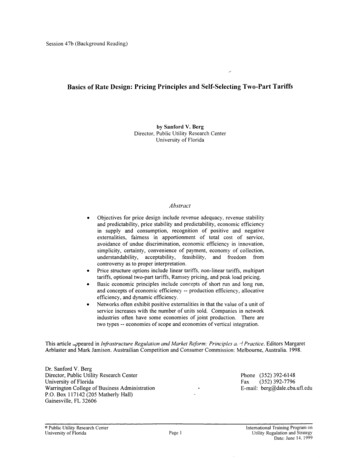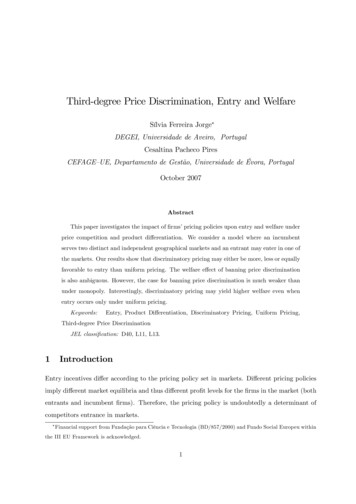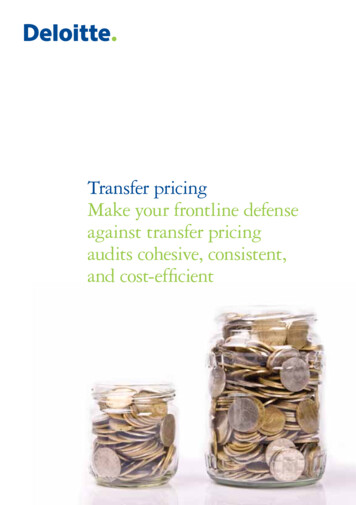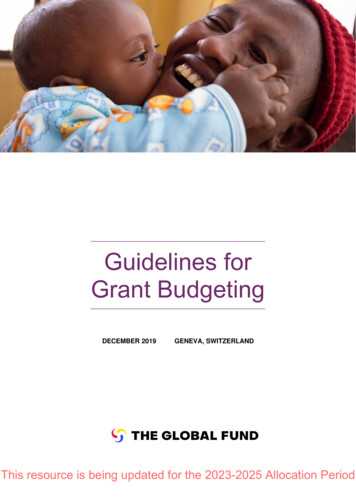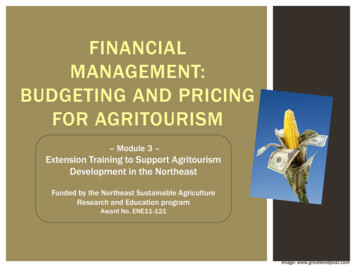
Transcription
FINANCIALMANAGEMENT:BUDGETING AND PRICINGFOR AGRITOURISM– Module 3 –Extension Training to Support AgritourismDevelopment in the NortheastFunded by the Northeast Sustainable AgricultureResearch and Education programAward No. ENE11-121Image: www.greatbendpost.com
KNOW YOUR INCOME GOALSMost often, agritourism enterprises are developed to expand farmincome. It is important to carefully define income goals. Forexample: Break even/turn a profit in the fir st year. Provide supplemental income while holding a full -time job of f -farm. Earn all of my (my household’s) income from farming [within a specified timeframe]. Meet current and long -term family income needs (e.g., college tuition, healthinsurance, retirement planning). Expand farm income enough to allow my children to become par tner s in thefarm business.Income needs from the farm business will change over one’s lifetime. Revisit goals periodically and evaluate progress towardthem.Source: Sullivan, P. & Greer, L. (2011). Evaluating a farming enterprise. National Sustainable Agriculture Information Service. 20pp.
PARTIAL BUDGETING Partial budgeting is an importantdecision-making tool for comparingthe costs and benefits of alternativesfacing a farming business. Importantly, only changes in farmfinances specifically attributed to anenterprise alternative are examined. For example, consider a producer of300 acres of corn that iscontemplating the construction of a5-acre corn maze. A partial budget reflects only the incomeand expense differences due directly tothe corn maze (e.g., design andmaintenance costs, added insurance andlabor, ticket revenues, etc.).Partial Budgeting Framework1. Define the potential enterprisechange2. List the added returns3. List the reduced costs4. List the reduced returns5. List the added costs6. Summarize the net effectsSource: Roth and Hyde (2002. PartialBudgeting for Agricultural Businesses.Penn State Agricultural Research andCooperative Extension.
THINK THROUGH POTENTIAL NEW OREXPANDED BUDGET ITEMSExamples to name a few B ui l dings ( n ew c o n s t ruc t i on o ri m provemen t s) In c re a sed ut i l i t i es c o s t s Fe n cin g Le g a l/ac c ount ing pro fe s s io nal N ew e q ui pm ent Pe rm i ts La n d Ta xe s La n ds c apin g M a i n tena nc e/deprec iat ion o f ex i s t in ge q ui pmen t o r i n fra s t ruc t ure H ay ri de wa g o n Si g n a ge H a n di cap a cce s sible a re a s Co rn m a z e de s i g n Re s t ro o m fa c i l i t iesH a n d wa s h i ng s t a t i o nsTi c ket bo ot h & t i c ket sC a s h re g i s te rIm prove d l i g ht ingTa bl e s & s e a t i ngPav ilion/te nt sAdde d i n s ura n c ePa rk i ng l ot ex pa n s i on/ i m provementsRet a i l s to re i nve ntor yFo o d & dri n k sIn c re a sed s t a f fi n gM a rket i ngA n i mals/pensS t a f f a ppa re l
POTENTIAL AGRITOURISMINCOME SOURCES Admission fee Tour fee Sales of fresh farmproducts Sales of processed orvalue added products Craft/souvenir sales Activity fee Tasting fee Facility rental Show fee (e.g., equine competition) Farm lodging Food serviceDon’t forget about grants or loans (e.g., Small Business Administration, RuralEconomic Development Agencies) & crowdsourced funding for projects (e.g.,Kickstarter, Crowdrise, IndieGoGo, Profounder, Spot.Us.).
PRICINGSetting an appropriate price point for eachproduct or service is critical. A farmer’s time is a limited resource and must be valued at anappropriate price. Analyze competitors’ pricing Examine trade publications Conduct research on target customers’ willingness to pay forproducts/services Know your costsPrice balance between1. Internal costs – production, marketing, etc.2. Market demand – what buyer will pay & competing products/services3. Strategic goals of the companyEvaluate price often and adjust as needed
BREAK-EVEN ANALYSISA useful tool to determine the minimum price per unit(e.g., visitor/ticket) required to cover all costs.Requires a careful enumeration of all fixed and variable costsassociated with a new agritourism activity.Fixed Costs (FC) do not varywith the number of guests.Examples: Construction/RepairsTaxes & InsuranceMarketingDepreciationVariable Costs (VC) will varywith the number of guests.Examples: Employee wages Fuel SeedBreak-Even Point Total Fixed Costs / (Price –Variable Costs)
SIMPLIFIED* EXAMPLE - HOW MANY 1-HOUR FARMTOURS DO I NEED TO OFFER IN ORDER TO BREAK -EVENON MY INVESTMENTS IN FARM INFRASTRUCTURE?Total Fixed Costs (TFC): 4,000 Insurance 1 ,000Improved parking area 1 ,000Farm Market Improvements 1 ,500Child play area 500Variable Costs (VC): 40 Wages (5 worker s @ 8/hr) 40 Fuel 10Cost charged per tour (P): 100* Simplified example – no depreciation, newequipment, taxes, interest payments on purchasedassets, etc. are being considered.BE TFC / (P – VC)BE 4000 / ( 100 - 50)BE 4000 / 50BE 80 farm tours*Anything over 80 tours profit/return tooperatorAre 80 farm tours feasible?Is it consistent with time commitment expectations?Would a higher price (and thus lower BE) be acceptedby my customers?What are my (operator) income goals and how manymore tours would be required?How sensitive is the estimated break-even point tomy pricing/budget assumptions?From Schilling, et al. (2011). Marketing 101 for your agritourism business. Rutgers Cooperative Extension.
A MODIFIED BREAK-EVEN ANALYSIS The preceding example can be modified to incorporate a desiredprofit/return to operator using the Cost and Profit Method EXAMPLE: Assume the farmer plans to host 100 1 -hour farmtours this season. She wants to earn a return (profit) of 3,000from farm tours (roughly 30/hour). What price point should becharged? First calculate: [Total Fixed Costs Total Variable Costs Total Profit] [ 4,000 (TFC) 5,000 (TVC) 3,000 profit] 12,000 total revenueneeded Next calculate the price point required per tour to earn the needed levelof revenue needed to cover costs and yield the desired level of profit 12,000/100 tours a price point of 120/tour
ADDITIONAL CONSIDERATION FORDETERMINING PRICE Perceived buyer value Price based on the perceived value in the eyes of the buyer Identify the segment of market who will value product/service most Requires research For example: survey potential/current users; follow -up with current customers, etc. Type of buyer May have various prices, options, bundles depending upon the type or group ofbuyer to whom you are marketing (e.g., frequent customers, bulk orders, etc.) Price as indicator of quality In certain circumstances, price quality and higher price higher quality Based on competitors Keep in mind the uniqueness of a product can be a selling point for a higher priceBe sure to price high enough to cover costs and make a profit !Evaluate your prices often and make adjustments as needed!
SEGMENTING MARKETS BYINFLUENCERS Price Segment Seek to buy at lowest price, some level ofquality Not very attractive customer unless competingentirely on price Loyal Buyer Strong preference for one brand based onreputation, tend not to evaluate alternatives Less worried about cost – want a relationship& connection Value Segment Limited incomes, sensitive to differencesamong products, carefully check all features,pay high price only if it’s “worth it” Hardest to keep happy Convenience Buyer s Not concerned about differences amongbrands or costs Need to solve a problem for buyer May make impulse buysKnow your intended customer &what influences them.Be realistic with who you want toattract & who you can attract!Source: Dawn Thilmany McFadden, Colorado State University
“IF YOU DON’T HAVESOME CUSTOMERSTHINKING YOU CHARGETOO MUCH, THEN YOUAREN’T CHARGINGENOUGH!”- DAW N T H I L M A N Y M C FA D D E N , C O LO R A D O S TAT E U N I V E R S I T Y
NEW PRODUCT/SERVICEPRICING STRATEGIES Skimming (Skim Pricing) Charge high price for new service – early adopters/customers are notvery price sensitive Price can be lowered to reach more buyers Price high during introduction but lower as competitors enter Works best when buyers are insensitive to price Penetration Pricing Opposite of skimmingLow price initially to penetrate mass market quickerAs market share is gained, price increasesWorks well when buyer is sensitive to price
ADDITIONAL PRICING STRATEGIES Odd-Even Take advantage of human psychology & emotional buying. For example: 499.95vs. 500 Bundle Offer 2 products together for one price. For example: Corn Maze Pumpkin orCorn Maze Ice Cream Discount/Promotional Buy 1 Get 1 Line Pricing Levels of pricing - price & productsreceived increase with each option level Option 1 – pay for each activity individually Option 2 – provides access to X activities Option 2 – full access to all activities Optional Pricing Add-on, optional extrasImage: blacklocus.com
KEEP GOOD RECORDS Records do not have to be detailed or complex to be useful! Records allow producers to: Analyze progressIdentify areas of good (poor) performancePlan for the futureDemonstrate ability to lenders Suggested records to keep Balance sheetIncome statementCash flow statementEnterprise budgetFor more information, refer to:Financial Management & Analysis’ Rod Sharp, Colorado State University - http://tinyurl.com/p7o3ndhAgritourism and nature tourism in California, University of California Agriculture and Natural Resources http://sfp.ucdavis.edu/agritourism/Image: credithelp.dnb.com
EXIT STRATEGY Part of a good financial plan is having an exit strategy Specify situations in which the business or parts of the business would close Doing something in today or in the future simply because itwas done in the past may not be the most sensible businessdecision The economic viability or desirability of certain farm activitiesmay change over time An activity may become less (more) profitable over time A successful agritourism will adapt and be responsive toevolving market opportunities – changes will occur Sometimes a good idea simply runs its course
“Sound financial analysis is nolonger an option but a necessityfor survival”- Rod Sharp, Colorado State University
FINANCIALMANAGEMENT:BUDGETING AND PRICINGFOR AGRITOURISMQUESTIONS?COMMENTS?Image: www.greatbendpost.com
FUNDING ACKNOWLEDGMENTSupported by a grant from the Northeast SustainableAgriculture Research and Education programAward No. ENE11 -1 21 , “Development of Extension Programming toSuppor t the Advancement of A gritourism in the Nor theast”
PROJECT TEAMProject Director Brian Schilling, Rutger s Univer sityCo-Project Directors Lisa Chase, Univer sity of Vermont Stephen Komar, Rutger s Univer sity Lucas Mar xen, Rutger s Univer sityProgram Development Team William Bamka, Rutgers UniversityRichard Brzozowski, Univer sity of MaineMichelle Infante -Casella, Rutger s Univer sityMeredith Melendez, Rutger s Univer sitySamantha Rozier -Rich, EnRiched ConsultingKevin Sullivan, Rutger s Univer sityLaurie Wolinksi, University of Delaware
CONTACTSProject DirectorBrian SchillingA s s i s t a n t E x te n s i o n S p e c i al i s tRu t g e r s C o o p e r a t i ve E x te n s i o nRu t g e r s , T h e S t a te U n i v e r s i t y o f N ew J e r s eyC o o k O f f i c e B u i l d in g , Ro o m 1 0 85 5 D u d l ey Ro a dN ew B r u n s w i c k , N J 0 8 9 01Te l : ( 8 4 8 ) 9 3 2 - 91 27s c h i l l in g @ a e s o p .r ut g e r s . e d u
Rutgers Cooperative Extension Rutgers, The State University of New Jersey Cook Office Building, Room 108 55 Dudley Road New Brunswick, NJ 08901 Tel: (848) 932-9127 schilling@aesop.rutgers.edu CONTACTS
